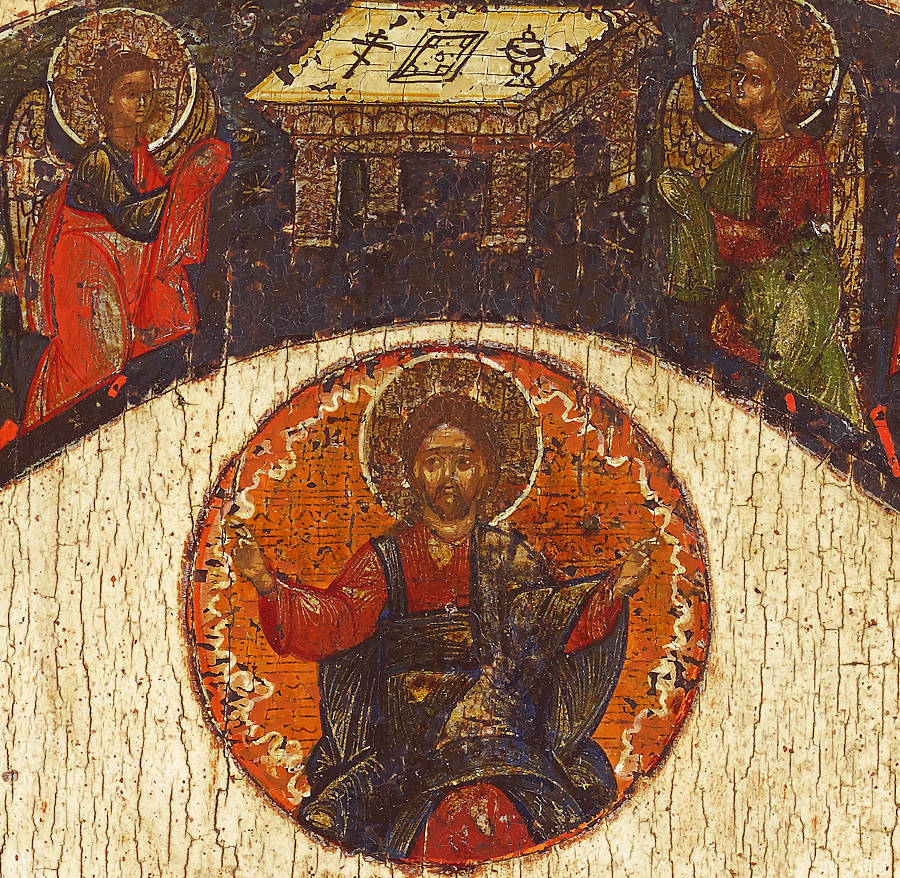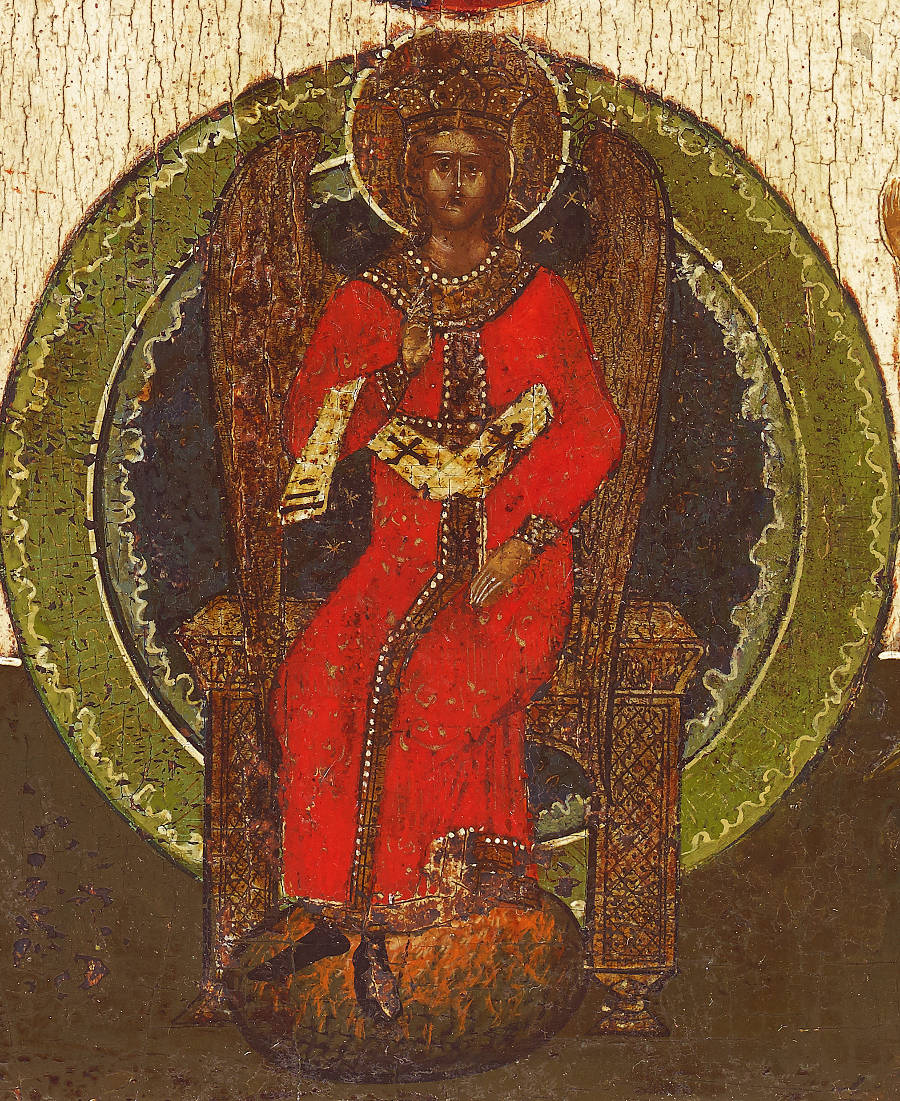 Exhibitions Archive
Exhibitions Archive
 Exhibitions Archive
Exhibitions Archive

AZ12. Sophia Wisdom of God,
Russian, Palekh School, 19th century
Panel: 26.7 x 22 cm; 2.1cm thickness![hideselects= [On] header =[Convert size] body = [Click here to show the size in inches] Click here to convert metric size to imperial](images/inches.gif)
Provenance: German art market



The following is abridged and partly adapted from Laurence Maxwell’s study of the subject published at http://www.templegallery.com/main.php?mode=3&p1=2684
In the centre of the panel is an enthroned angelic figure (Sophia) wearing Byzantine imperial dress, including a crown, and blessing with the right hand. Sophia is surrounded by green, concentric circles of clouds representing the celestial sphere. She is dressed in red. Her feet rest on a spherical shaped footstool, representing the world (see Isaiah 66:1; Matt. 5:35; Acts 7:49), and the Ark of the Covenant (1 Chr. 28:2; Ps. 99:5; Ps. 132:7). As in the Deesis iconography, Sophia is attended by the Mother of God (on the left) and John the Baptist (on the right). Above the Virgin’s chest we see a chora showing Christ Emmanuel, the iconic representation of Christ as the Logos. While the Baptist holds an open scroll with an inscription from the Gospel of John: ‘Behold the Lamb of God, who takes away the sins of the world’ (1:29). Above Sophia - in another mandorla - is an image of Christ the Saviour in half-length. At the top of the panel we see the 'scroll of heaven' (Rev. 6:14) with the hetoimasia in the centre with a closed Gospel, a cross and a chalice. Six angels (three on either side) surround the hetoimasia1. They are shown in 'divine conversation' as they support the 'scroll of heaven'. Two female martyrs, probably St Parascevi and St Anastasia, family saints, are represented on the borders.
The iconography of Sophia the Sacred Wisdom developed in Novgorod in the fifteenth century and was then brought to Moscow soon after. The main cathedral in Novgorod is named after Sophia, and the earliest known icon of this subject is still located there (Fig. 1)2. It is important not just because of its rarity, but because of its significance in the history of icons and religious thought. One of its distinguishing features is the fact that it doesn't represent an historical scene or figure, but is wholly allegorical, as Donald Fiene states: 'Quite probably no other icon type was (or is) so abstract or allegorical in its content.' Kornblatt adds that 'images of wisdom remain the most abstract of all holy pictures3.'
Fig. 1. Sophia Wisdom of God, Novgorod, mid-15th c, St Sophia Cathedral, Novgorod, Russia
Though the angel is clearly feminine, according to tradition she represents Christ as Holy Wisdom (Sophia). Wisdom is a theological concept that was important in the early Judeo-Christian world, and is associated with creation, glory, purity, fertility, unity, righteousness and beauty4. Margaret Barker points out that 'possession of knowledge or wisdom had long been the sign of the angelic state5' while the redness of Sophia's dress can be connected to a passage from Revelation (10:1).
The symbolic language of the iconography makes direct reference to the Hebrew Wisdom tradition, with a visual appropriation of a passage from Proverbs: 'Wisdom has built her house.' (9:1). Though the theme of Wisdom has its roots in the early Judaic world, it was applied to Christ and became an important theme in Neoplatonism and late antique Gnosticism. Clement of Alexandria (150-215 CE) highlights a meeting point between these traditions concerning Wisdom: ‘If then we assert that Christ himself is Wisdom, and that it was His working that showed itself in the prophets, by which the Gnostic tradition may be learned, as he Himself taught the apostles during his presence; then it follows that the gnosis which the knowledge and apprehension of things present, future and past which is sure and reliable, as being imparted and revealed by the Son of God, is Wisdom.’ (Misc.6.7)
Many scholars see a connection with the conception of the Sophia iconography and Hesychasm. For example, Wisdom (and its identity with Christ) was one of the key arguments used by Gregory Palamas in the Hesychast controversy of the 14th century, as Anita Strezova points out: 'Wisdom was one of the subjects discussed during the Hesychast controversy, resulting in a symbolic image of Sophia...The supporters of Palamas...interpreted the meaning of Sophia in the context of their Christology, to support Palamite doctrine of Christ as the Wisdom of God6.' Thus, the current iconography can be seen as fusing Hebrew, Patristic, and Palamite ideas relating to Wisdom into a composite image. The icon therefore represents a meeting-point between an ancient theological/philosophical concept and its reconfiguration through different cultures and practices.
In Russia during the 19th - 20th century, Sophia, with its philosophical roots derived from Hebrew and Byzantine tradition, became an important concept and symbol for theologians, philosophers and poets. Their ideas became known as Sophiology and were highly controversial within the Orthodox Church7. The symbolism of the Novgorod Sophia icon was used, most importantly by the philosopher Vladimir Solovyov, to justify their ideas8.
The icon can be seen, then, as an unusually good example of allegorical imagery that captures the tradition of Wisdom - from its Hebrew roots to its connections with Hesychasm - and thus as a symbolic paradigm of Russian culture from the fifteenth century through to the nineteenth. The image represents one of the most important iconographic programs to emerge from Russia, and one of the most challenging.
Fig. 2. Back of panel
Footnotes:-